
Gender-inclusive participation in the sciences allows both men and women to fully benefit from advancements in science and technology.
The past year revealed both the interconnectedness of and the challenges facing the global community. As scientists rushed to create a vaccine, COVID-19 claimed lives and stalled economies. While the pandemic dominated global headlines throughout 2020, climate change remained an ominous and growing threat. Not only was 2020 one of the hottest years on record, the changing climate contributed to massive wildfires in Australia and the United States, intense hurricanes in the Atlantic, and locust swarms in East Africa.
Given the challenges confronting the world, it is unconscionable that scientific advancements may be hindered by gender inequalities. This, however, remains a disturbing global trend.
Gender disparity in the sciences
According to the UNESCO Institute for Statistics, women are underrepresented in the sciences, making up only 29.3 percent of researchers globally. For women who manage to successfully enter science-based careers, challenges remain. Studies have shown that women are discouraged from, or become less interested in, entering the fields of science, technology, engineering and math (STEM) beginning at a young age. And according to the Pew Research Center, women remain underrepresented in engineering, computer science and physical science.
The language used when referring to scientists is mostly the ‘he’ pronouns, you rarely hear the ‘she.’
Annet Mulema, Science Officer at the CGIAR Research Program on Climate Change, Agriculture and Food Security’s (CCAFS) Gender and Social Inclusion Flagship
Research also reveals that women in science, technology, engineering, and mathematic (STEM) fields are paid less than their male counterparts, are less likely to publish their research, and are not promoted at the same pace of men.
Recognizing the need to combat gender inequities in the sciences, the United Nations General Assembly in 2015 declared February 11th as the International Day of Women and Girls in Science to promote the full and equal participation of women and girls in science.
Building an enabling environment
Creating an enabling environment for women and girls to pursue scientific education and careers, however, remains a challenge.
As Katie Tavenner, a gender research specialist and international consultant explained, “The challenges that women and girls face are multi-faceted and varied across the globe, but they tend to cluster around lack of access to resources, lack of access to opportunities, and, crucially, existing stereotypes and gender biases that may prevent women from even considering the possibility of entering these fields.”
Similarly, Todd Crane, Senior Scientist, Climate Change Adaption, with the International Livestock Research Institute (ILRI), noted that, “Systemic obstacles are fairly well known in terms of girls, even from a young age, not getting encouragement or support to go into science-based careers.”
Echoing this, Mulema, points to the lack of role models for girls and young women. “When you don’t have somebody to encourage you,” she said, “it becomes difficult to be interested in science.”
But despite challenges of gender discrimination and lack of recognition in the scientific community, countless inspiring women have made historic contributions to science and helped advance understanding of the world around us. Many were not recognized in their own lifetimes, but their achievements have helped generations to come.
A gender-inclusive approach to scientific research not only supports women researchers but ensures that both women and men fully benefit from the scientific process. For example, research points to gendered access to resources and climate-related priorities, making gender-disaggregated data an important component for the design and implementation of climate-smart agriculture (CSA) technologies.
It is imperative that we work towards a future where scientific advancement is unhindered by bias and stereotypes. While the International Day of Women and Girls in Science is an opportunity to celebrate the contributions of women and girls, it is also a reminder of the work that still needs to be done.



